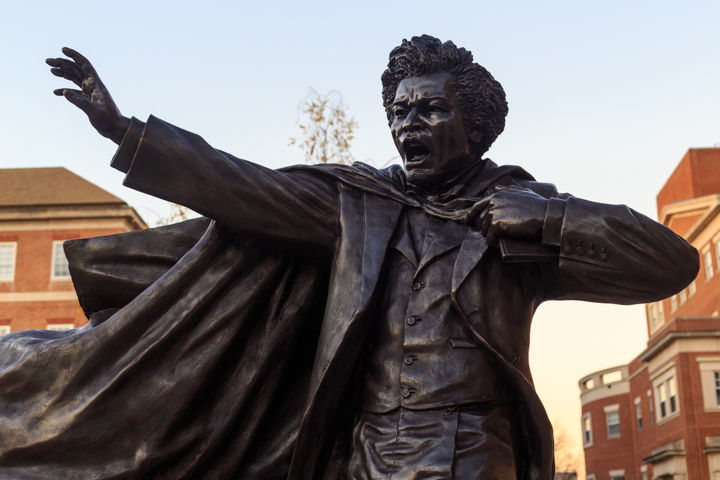
A new statue of Frederick Douglass stands in Hornbake Plaza.
A Facilities Management-led team installed a statue of Frederick Douglass outside of Hornbake Library on Sunday after about five years of planning, construction and anticipation.
With construction on the rest of Frederick Douglass Square concluded in September, the roughly 8-foot-tall statue underwent a three-week voyage last month from Ireland to the United States, said Patrick O’Shea, vice president and chief research officer for the university’s Division of Research. No additional construction will occur on the plaza, said Darwin Feuerstein, Facilities Management assistant director for site projects.
An official dedication ceremony will take place at the square Nov. 18 at 2 p.m. to honor the famous orator and writer, who spoke passionately in favor of abolition and wrote several books about his life as a slave in Talbot County.
The speakers for the event are being finalized this week, said Elise Carbonaro, communications director for the Division of Research.
READ MORE: UMD finalizes construction for Frederick Douglass square
The dedication ceremony marks the end of an extensive journey that began as early as 2011, said Patrick O’Shea, vice president and chief research officer for the Division of Research. He said the statue’s presence on the campus is unique in the university’s history.
“There’s some other statuary here, but this is going to be quite different,” O’Shea said. “There aren’t a lot of people statues on this campus. I think people will notice this.”
The statue, designed in Ireland and cast in bronze in Wales, is mounted on a 3-foot-tall base and weighs about half a ton, O’Shea said.
O’Shea, who has connections in Ireland, said he helped the university acquire the statue upon learning of the university “North Star” committee’s intent to honor Douglass. He said work on the statue design began in Ireland in 2011, about the same time history professor Ira Berlin and the rest of the “North Star” committee were beginning to discuss ways to recognize the distinguished reformer.
“It was not a linear process,” O’Shea said. “It kind of came together in a loosely collaborative way.”
Frederick Douglass Square cost about $600,000 to complete and includes benches, lighting, plant beds and many of Douglass’ quotes carved into pavers and a steel wall. The statue cost about $200,000.
READ MORE: UMD to build memorial honoring Frederick Douglass in Hornbake Plaza
“He was one of the first people to deal with human rights on a broader scale,” O’Shea said. To highlight Douglass’ role in civil and human rights and the abolitionist movement, O’Shea said, the statue’s designer, sculptor Andrew Edwards, drew inspiration from artwork depicting President Obama and Moses.
“There’s a lot of complicated imagery going on here,” O’Shea said. “It’s so dynamic.”
The statue presents Douglass midspeech with one arm outstretched and a copy of his autobiography tucked under the other. O’Shea said the majority of other statues depict Douglass later on in life, but this one captures him in his mid-20s, when the escaped slave found refuge in Ireland as his book was published in the United States.
O’Shea said during Douglass’ time in the Irish city of Cork, he lived within walking distance of a young girl named Mary Harris, who eventually immigrated to the United States. In the early 1900s, she “was considered the most dangerous woman in America” because of her ability to organize mine workers and their families to protest against mine owners, O’Shea said. An elementary school honoring Mary Harris “Mother” Jones is located just a few miles away from this university in Adelphi.
“It’s a curious parallel,” O’Shea said. “It indicates a broader history. This is more than just a statue.”
READ MORE: USM Board of Regents unanimously approves Art-Sociology Building name change
Architecture Dean David Cronrath, who assisted in completing Frederick Douglass Square, said the statue’s presence relays the university’s mission to its onlookers.
“We’re a university that believes in truth and justice as being just as important as knowledge,” Cronrath said. “It gives us something to believe in.”
He also said the statue’s positioning on the plaza is symbolic as well.
“He’s not on axis with Hornbake for two reasons, the first being that he wouldn’t have wanted to be in absolute authority like a king or a general. That’s not who he was,” Cronrath said. “The second reason is when you approach the space … the hand moves away from his face, and it helps the statue control the space.”
And in addition to its appearance, Cronrath said the statue serves to connect Douglass to his state’s flagship university.



